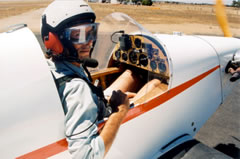Forester takes to the skies
Note: This content is stored on an archive website and may not be current or accurate. Contact us to clarify.
Senior forester Rod Clark spends many hours at work driving hundreds of kilometres throughout State Forests western region managing the cypress forests around Forbes.
And when he’s off duty? He spends as much time as he can flying over the western region.
Rod’s private passion is his home-built Jodel Bebe D9, a low-wing open-cockpit ultra light he has lovingly built and flown over the past 20 years.
The plane did not have a quick birth. Rod first began the task in 1984, and the aircraft took shape from purchased materials and parts constructed in garages at his homes until its first flight in 1999.

Rod Clark at the controls of the Jodel Bebe ultralight he built himself
“I learned to fly in Casino under the legendary Neville Bienke in the early 1980s,” Rod says.
“Now I am a licenced private pilot and ultra light pilot.”
The craft is built from timber, albeit imported spruce as the plans called for, with a fabric skin.
“But the prop is from hoop pine (a native Australian which State Forests grows in plantation) which I designed myself and had milled from Pikapene State Forest timber,” Rod said.
The aircraft project has proved to be just what Rod intended.
“I wanted the challenge of building something that was exacting and complicated,” Rod said.
“I had to learn a number of new skills such as woodwork, aircraft welding and metalwork, installing controls and fabric working. The propeller I designed myself and that is a science all of its own.
“It works really well, but I did have an engineer check the design.
“The prop has to be modelled to suit the plane. It can’t be bought off the shelf.”
The project took him an estimated 2,000 to 3,000 hours, about right for a novice builder.
“I have built a few houses, and that is easy by comparison. In those you use established systems and it is not as exacting. In aircraft the tolerances are as small as a 100th of an inch,” Rod said.
The Jodel is a French design, dating back to the early 1950s. About 1000 have been built around the world, and at least another nine in Australia that Rod knows of.
It uses a Volkswagon 1700cc engine, which now has about 200 hours up.
Rod has flown his to 11,500 ft, and it cruises at 70 knots, which is about 130km/h. Maximum speed is 145 km/h.
The Forbes geography is perfect for the Jodel, where Rod tends to shy away from flying over forested areas, where there are few emergency landing options. He spends most of the day in forests anyway.
The rural areas around Forbes tend to have plenty of open paddocks just in case he has to glide the Jodel down.
Taking off is a thrill of its own. As the motor is started by manually turning the propeller, Rod has a rope he attaches to a hook at the rear to prevent the craft from getting away before he has a chance to slip into the cockpit.
Once in, he pulls a lever to release the rope from the hook and off he goes.
“I’ve got a good supply of rope in the cockpit, and there are bits of rope attached to fence posts right around the area,” Rod says.
There are other ultra light pilots and builders in the Forbes aero club, which also embraces light aircraft and gyrocopter pilots.
The flying and building bug has seriously bitten. Rod has a new project under way, a Pazmany PL4A.
The Pazmany is another ultra light design, this time with an aluminium skin. It is also a low-wing open cockpit monoplane, but the wings will fold so it can be towed on a trailer similar to a glider.
“This will mean I can tow it long distances for a holiday or an aircraft meet, fly it where I want and still have a car to get around in,” Rod said.
Rod is a mentor with the Sport Aircraft Association of Australia, which offers the growing band of dedicated home builders a means of overcoming difficult construction and design problems.
“I suppose you could say I am passionate about flying,” says Rod.
Media contact: Rod Clark on (02) 6852 2255.

